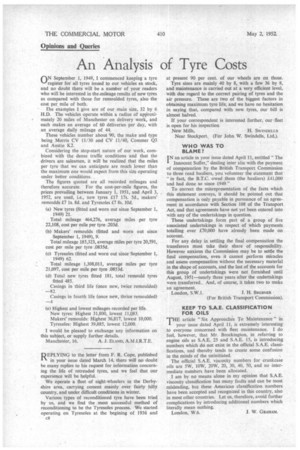An Analysis of Tyre Costs
Page 46

If you've noticed an error in this article please click here to report it so we can fix it.
nN September 1, 1949, 1 commenced keeping a tyre ‘-'register for all tyres issued to our vehicles ex stock, and no doubt there will be a number of your readers who will be interested in the mileage results of new tyres as compared with those for remoulded tyres, also the cost per mile of both.
The examples I give are of our main size, 32 by 6 H.D. The vehicles operate within a radius of apProximately 20 miles of Manchester on delivery work, and each makes an average of 60 deliveries per day, with an average daily mileage of 44.
These vehicles number about 90, the make and type being Morris CV 11/30 and CV 11/40, Commer Q3 and Austin K2.
Considering the stop-start nature of our work, combined with the dense traffic conditions and that the drivers are salesmen, it will be realized that the miles per tyre that we can anticipate are much lower than the maximum one would expect from this size operating under better conditions. .
The figures quoted are all recorded mileages and therefore accurate. For the cost-per-mile figures, the prices prevailing between January 1, 1951, and April 3, 1952, are used, i.e., new tyres £17 17s. 5d., makers' remoulds £7 Is. 8d, and Tyresoles £7 8s. 10d.
(a) New tyres (fitted and worn out since September 1, 1949) 21.
Total mileage 464,276, average miles per tyre 22,108, cost per mile per tyre .203d.
(b) Makers' remoulds (fitted and worn out since September 1, 1949), 9.
Total mileage 185,323, average nliles per tyre 20,591, cost per mile per tyre .0835d.
(c) Tyresoles (fitted and worn out since-September 1, 1949) 62.
Total mileage 1,308,011, average miles per tyre 21,097, cost per mile per tyre .0853d.
(d) Total new tyres fitted 181, total remould tyres fitted 4-85.
Casings in third life (once new, twice remoulded) —87.
Casings in fourth life (once new, thrice remoulded) —4 (e) Highest and lowest mileages recorded per life. New tyres: Highest 31,800, lowest 11,081 Makers' remoulds: Highest 36,817, lowest 10,000. Tyresoles: Highest 39,885, lowest 12,000.
I would be pleased to exchange any information on this subject, or supply further details.
Manchester, 16. A. J. ELAND, A.M.I.R.T.E.
REPLY1NG to the letter from F. R. Cope, published in your issue dated March 14, there will no doubt be many replies to his request for information concerning the life of retreaded tyres, and we feel that our experience will be helpful.
We operate a fleet of eight-wheelers in the Derbyshire area, carrying cement mainly over fairly hilly country, and under difficult conditions in winter.
Various types• of reconditioned tyre have been tried by us, and we find the most successful method of reconditioning to be the Tyresoles process. We started operating on Tyresoles at the begining of 1936 and c8 at present 90 per cent. of our wheels are on those.
Tyre sizes are mainly 40 by 8, with a few 36 by 8, and maintenance is carried out at a very efficient level, with due regard to the correct pairing of tyres and the air pressure. These are two of the biggest factors in obtaining maximum tyre life, and we have no hesitation in saying that, compared with new tyres, our bill is almost halved.
If your correspondent is interested further, our fleet is open for his inspection
New Mills, H. SWINDELLS Near Stockport. (For John W. Swindells, Ltd.).
WHO WAS TO BLAME?
IN an article in your issue dated April 11, entitled "The I Innocent Suffer," dealing inter alia with the payment of compensation by the British Transport Commission to three road hauliers, you volunteer the statement that "in fact, the B.T.C. owed them (the hauliers) £41,000 and had done so since 1949."
To correct the misrepresentation of the facts which this statement conveys, it should be pointed out that compensation is only payable in pursuance of an agreement in accordance with Section 108 of the Transport Act, and that agreements have not yet been entered into with any of the undertakings in question.
These undertakings form part of a group of five associated undertakings in respect of which payments totalling over £70,000 have already been made on account.
For any delay in settling the final compensation the transferors must take their share of responsibility. However anxious the Commission may be to settle the final compensation, even it cannot perform miracles and assess compensation without the necessary material in the shape of accounts, and the last of the accounts for this group of undertakings were not furnished until August, 1951—nearly three years after the undertakings were transferred. And, of course, it takes two to make an agreement.
. London, S.W.1. J. H. BRE13NER
(For British Transport Commission).
KEEP TO S.A.E. CLASSIFICATION FOR OILS
THE article "Six Approaches To Maintenance" in I your issue dated April 11, is extremely interesting to everyone concerned with fleet maintenance. I do feel, however, that Mr. Brockington, in referring to engine oils as S.A.E. 25 and S.A.E. 15, is introducing numbers which do not exist in the official S.A.E. classifications, and thereby tends to create some confusion in the minds of the uninitiated.
The official S.A.E. viscosity numbers for crankcase oils are 5W, 10W, 20W, 20, 30, 40, 50, and no intermediate numbers have been allocated.
I am by no means alone in my opinion that S.A.E. viscosity classification has many faults and can be most misleading, but these American classification numbers have been accepted and recognized in this country, also in most other countries. Let us, therefore, avoid further complications by introducing additional numbers which literally mean nothing. London, W.6. 1. W. GRAHAM.




















































































